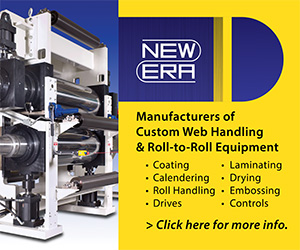Foil Substrates: Handling, Web Control & Substrate Interaction
- Published: September 22, 2015
If you'd like to hear from Mark Miller's own lips rather than read his blog, titled "Foil Substrates," click on his podcast below:
{mp3}foil-substrates-voice{/mp3}
To start with, the foils are processed prior to the coating procedure and are typically sprayed with oil. This oil needs to be removed or considered before applying the coating. The surface tension of the substrate will be undermined by the presence of the oil. In addition, the foil will be annealed (heated) in order to form the right crystallized structure within the metal itself.
Annealing the foil creates a roll of foil that is even and easier to coat. However, in the annealing process, unwanted oxidation may occur. Oxidation will result in the foil blocking. This inability to unwind the foil will cause issues similar to converting a block roll of tape.
Ultimately we are looking for a roll of foil that unwinds easily, without excess oil and allows for good wettability of fluids. If oils have not been removed substantially, the wettability will be lower in the middle of the foil and better at the edges. If beading up occurs on the center of the foil substrate, further oil removal is required. Wettability of foils is more important as you move towards water-based fluid coating. Solvent-based fluid coating can typically attack the foil substrate surface better to form a coated product.
In addition to wetting of the substrate, spreading of the fluid on the substrate is also important. For many applications, this is viscosity driven – the higher the viscosity the less the fluid spreads on contact. Spreading can be controlled with temperature in addition to solvent/solids concentration.
If the fluid and foil do not play well together, consideration of a tie layer between the two may help. This chemically compatible layer of coating can allow the foil to be purchased with less “purification” of oils and the functional coating to not be chemically modified to accept the substrate wettability. This tie layer would typically be pre-coated on the foil prior to the functional coating, but may be coated simultaneously if the interfacial chemistry between the two fluids allows consecutive flow.
Once the fluid is coated on the foil, drying and curing need to be considered in addition to web handling. Because the foil is less permeable than films and paper, the interaction of potential migrating materials within the fluid needs to be considered. Components that would typically migrate in a paper coated product are held between the foil and substrate. These trapped components may potentially cause coating defects or de-laminations not experienced in paper or film. The curing method (oven, electron beam or UV) may also play a role in defect formation with foils that is differentiated from paper or film. The key feature is to remember that the only escape route for the fluid is back through the fluid.
Foils are unique in their application and process-ability, but the added benefit can be worth the effort. Energy storage devices, food packaging and many other areas can benefit from investigation into the interfacial intricacies of fluid foil coating.







